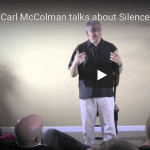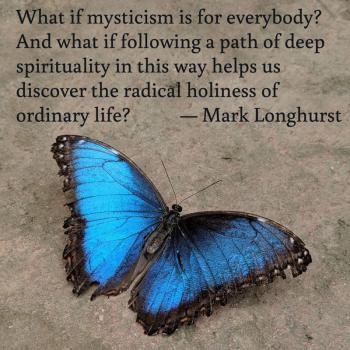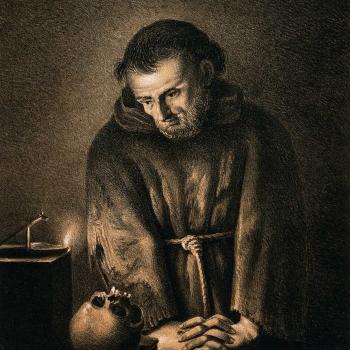 Mysticism is a notoriously squirrelly word to try to define. In The Big Book of Christian Mysticism I devote an entire chapter to defining mysticism, and even then I admit that defining this word is like trying to put love into a bottle.
Mysticism is a notoriously squirrelly word to try to define. In The Big Book of Christian Mysticism I devote an entire chapter to defining mysticism, and even then I admit that defining this word is like trying to put love into a bottle.
Not long after the book was published in 2010, I was asked to lead a Friday/Saturday retreat at a Disciples of Christ Church near where I live. The topic for our time together was mysticism and contemplation. During the first talk of the weekend, I offered the participants “five ways of thinking about mysticism.” Recently I came across my notes from that conference, and I thought this was worth sharing with readers of this blog.
- “Mysticism” is to “religion” like loving God is to knowing about God. In his classic book Knowing God, evangelical author J. I. Packer draws the distinction between “knowing about God” and actually “knowing God.” The first is abstract, second-hand knowledge; the second is experiential, embodied, relational knowledge. Packer’s point: to truly be a person of faith, we need that embodied/experiential knowledge of God. I’m taking that same distinction and applying it to mysticism and religion. You can survive in religion by merely knowing about God — but if you truly want to enter into the mystery of God, then it’s time to gaze into the eyes of Love — and to trade in your abstract knowledge for face-t0-face love.
- Mysticism invites us into a realm of paradox and play: “Become like little children” (Matthew 18:3). Despite what some critics may insist, mysticism is not irrational — some of the greatest mystics were great theologians and/or philosophers. But while mysticism is not irrational, it does point us to a place of trans-rational relationship with God: a relationship that invites us beyond the limitations of human reason, logic, and language-based cognition. It invites us into the trans-rational space primarily through silence, but also through a playful relationship with language. Many of the great mystics were poets, or prose writers who wrote poetically. And some — like Meister Eckhart, for example — used playful or paradoxical imagery and language to try to convey what ultimately cannot be put into words.
- Mysticism is commonly equated with experience — but authentic mysticism propels us into a place deeper than mere experience. This is an expansion on the first point: that embodied experience trumps secondary knowledge. But the rabbit-hole goes deeper, for some of the greatest mystics — figures like John of the Cross, Pseudo-Dionysius, Eckhart, and the anonymous author of The Cloud of Unknowing — point out that God ultimately cannot be captured by any human experience, so the true encounter with God takes us to a place beyond experience. After all, experience can be a source of ego-inflation or self-referential awareness: an experience can imply that “I” am the subject and “God” a mere object. But God, the true God, is always subject, never object. So a truly mystical encounter is an objectless experience — which is a mysterious experience indeed.
- Mysticism is about practice: it’s not what we think, but what we do. At the same time, mysticism takes the spotlight off of what we do and trains it on what God does. Yes, there is something called “mystical theology” but the heart of mysticism is not how we talk about it, but how we live it. Mysticism is about silence, about embodiment, about relationship, about love — in other words, about how the encounter with God (the ultimate mystery) really can’t be put into words. The Cloud of Unknowing said it best: you can’t think your way to God. God cannot be apprehended by thought, but may be encountered through love. Just remember: it’s all God’s initiative! We do not achieve mystical union with God, we receive it.
- Mysticism celebrates words, images, thoughts, ideas about God — and then asks us to surrender all our words, images, thoughts and ideas about God before the great silence of the Divine Mystery: the ineffable Presence. This is analogous to the relationship between dreams and deep sleep, or between distracting thoughts and contemplative silence. There are two dimensions to mystical prayer and contemplation: the kataphatic path of encountering God through words, images, and concepts of God; and the apophatic path of surrendering all words/images/concepts in order to meet God in the sheer mystery of darkness and unknowing. Apophatic mysticism is pure gift: once again, not something we achieve but by grace something we receive. It seems that few people are called into a purely apophatic relationship with God: most of us meet God through the beauty of God’s creation, in some form or fashion. Anything, after all, can be an icon of the mystery: we might meet God through other people, through the church (community and/or the building), through art and poetry and music and architecture, through the splendor of nature. All of these “ways of meeting” God are kataphatic: they all usher us into the divine presence through an image, thought, or concept. But sooner or later, even the most exalted kataphatic mystic will be invited to surrender all the ways we meet God through creation: and instead, we are called into silence, into darkness, into mystery, into unknowing. Into a place that cannot be put into words or described or depicted or even thought about. The cloud of unknowing; the dark night of the soul. There, the encounter happens. It is mystery; it is grace.
I hope these portals into the mystery which is mysticism are helpful or evocative for you. Let me know if you have other ideas for ways to think about, or experience, or encounter, the mystical dimension of Christianity.
Note: This is expanded from the notes of a talk I gave at First Christian Church (Disciples of Christ) in Atlanta, GA on October 1, 2010. I stumbled across these notes recently while going through some old papers, and I thought this was worth preserving/revisiting on my blog. Hope you enjoy it.
Enjoy reading this blog?
Click here to become a patron.














